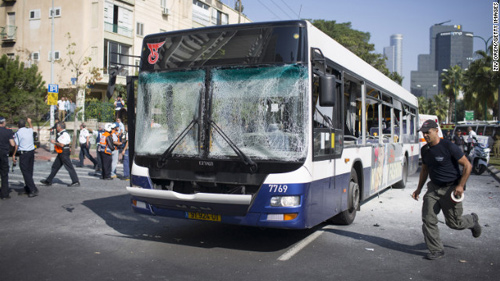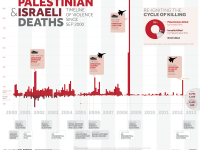Edited by: Ac: Krtashivananda
In The Politics of Genocide, Edward Herman and David Peterson wrote: ‘The vulgar politicisation of the concept of genocide, and the “emerging international norm” of humanitarian intervention, appear to be products of the fading of the Cold War, which removed the standard pretexts for intervention while leaving intact the institutional and ideological framework for its regular practice during those years.’
We Must Blow Gaza Back To The Middle Ages
With the above in mind, consider that, on November 16, on the third day of Israel’s latest assault on Gaza, with at least 18 Palestinians already killed, the BBC reported: ‘Israel’s aerial bombardment of Gaza has intensified after it authorised the call-up of 30,000 army reservists, amid reports of a possible ground offensive.’
Israel’s cabinet quickly approved the activation of 75,000 reservists, as well as hundreds of Merkava main battle tanks, armoured bulldozers and other assault vehicles, which were transported into position for attack.
Was a massacre looming? The Israeli deputy prime minister Eli Yishai appeared to promise as much on November 18: ‘We must blow Gaza back to the Middle Ages destroying all the infrastructure including roads and water.’
A prominent front-page article in the Jerusalem Post by Gilad Sharon, son of the former Israeli prime minister, Ariel Sharon, openly advocated mass killing:‘We need to flatten entire neighbourhoods in Gaza. Flatten all of Gaza.” ‘There should be no electricity in Gaza, no gasoline or moving vehicles, nothing. Then they’d really call for a ceasefire.’
Was the call to ‘Flatten all of Gaza’ beyond the pale of respectable discourse? Apparently not for the BBC, which quoted a less frenzied comment by Sharon three days later. Recall the human cost of Operation Cast Lead, Israel’s three-week offensive waged between December 2008 and January 2009. The Israeli human rights group B’Tselm reported:
‘The magnitude of the harm to the population was unprecedented: 1,385 Palestinians were killed, 762 of whom did not take part in the hostilities. Of these, 318 were minors under age 18. More than 5,300 Palestinians were wounded, of them over 350 seriously so.’
There is no question, then, that a ‘Benghazi moment’ had arrived for Gaza around November 16 or shortly thereafter. A Cast Lead-style massacre of hundreds, perhaps thousands, of civilians was a very real possibility. Did Hamas rockets had killed more civilians, for example in Tel Aviv?
Gaza is under decades of military occupation and years of siege, greatly strengthening the moral case for external intervention. Escape from a ground assault would have been completely impossible for Gaza’s 1.6 million people, about half of them children. Gaza has been targeted by the most advanced weaponry US taxpayers’ money can buy.
By any reasonable accounting, then, the case for a no-fly zone, indeed a no-drive zone – some kind of humanitarian intervention – was far more compelling for Gaza than it had ever been for Libya. And yet our search of the Lexis media database found no mention in any UK newspaper of even the possibility of setting up a no-fly zone over Gaza. There was no reference to Gaza’s ‘Benghazi moment’.
We saw no commentary suggesting that Western military action might have been justified to prevent a massacre of civilians in Gaza.
Terror attack in Tel Aviv?
 One week into Israel’s Operation Pillar of Cloud, on a day when 13 Palestinians were killed – with more than 136 people in Gaza killed by that point in 1,500 attacks since the operation began on November 14 – 28 people were injured in a Tel Aviv bomb attack. ITV News’s international editor Bill Neely commented: ‘Tel Aviv bus bomb is first terror attack there in 6 years.’ And: ‘Israeli Police confirm terror attack.’
One week into Israel’s Operation Pillar of Cloud, on a day when 13 Palestinians were killed – with more than 136 people in Gaza killed by that point in 1,500 attacks since the operation began on November 14 – 28 people were injured in a Tel Aviv bomb attack. ITV News’s international editor Bill Neely commented: ‘Tel Aviv bus bomb is first terror attack there in 6 years.’ And: ‘Israeli Police confirm terror attack.’
We wrote to Neely: ‘Bill, are the attacks on Gaza “terror attacks”? Have you described them as such?’
Neely wrote again;’A bomb on a bus, like a missile, is terror weapon.’
‘’Is This What They Mean By The Cycle Of Violence?’
The November 21 bus bombing, injuring 28 Israelis (initially reported as ten injured), was a far bigger story for the media than the killing of 13 people in Gaza that day. The bias was reflected in the tone of coverage. The BBC reported ‘Horror in Israel’ whereas they had earlier referred to a ‘difficult night for people in Gaza’ after 450 targets had been struck with scores of people killed.
The final death toll of the latest massacre is horrifying: 103 of the 158 people killed in Gaza were civilians. Of these, 30 were children – Twelve of them under ten-years-old. More than 1,000 Palestinians were injured. Six Israelis were killed, two of them soldiers. This infographic provides a shocking comparison of numbers killed on both sides since 2000. And this excellent little animation asks: ‘Is this what they mean by the cycle of violence?’
Inevitably President Obama said: ‘we will continue to support Israel’s right to defend itself’. Noam Chomsky has been a rare voice making the counter-argument:
You can’t defend yourself when you’re militarily occupying someone else’s land. That’s not defence. Call it what you like, it’s not defence.’ Obama also said: ‘There is no country on Earth that would tolerate missiles raining down on its citizens from outside its borders.’
Try telling that to the many bereaved in Pakistan, Afghanistan and Yemen. Irony is ‘dead,’ it seems – killed by drone-fire.
A war was fought without an Israeli ground assault but with massive air and rocket attacks on both sides. Israel did not have the appetite and perhaps the power to crush Hamas. Hamas did not have the power to compel Israel to change its policies but wanted to achieve a symbolic victory against Israel. Both decided that continued fighting made little sense. And 23 rd Nov. they agreed on a cease fire brokered by the Americans and Egyptians to for a settlement. Everyone from Iran to the Egyptian Muslim Brotherhood played a role, and then the curtain on this act went down for the time being to flare it again till Gaza cease to remain an open air prison. Freedom is the birth right of every citizen.
Source: Media Lense – David Edwards




